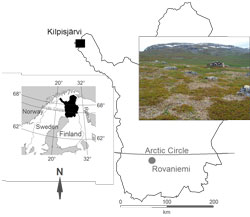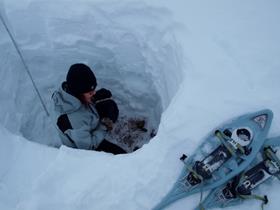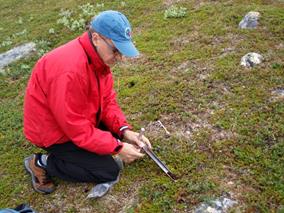Approximately one-third of the global soil carbon pool is stored in Arctic and boreal ecosystems and biodegradation of sequestered carbon in these regions is thus expected to be a significant contributor to atmospheric chemistry and climate. A major limitation in forecasting greenhouse gas emissions is our incomplete understanding of the dynamics and activity of Arctic and boreal soil microbial communities, especially while frozen. Factors such as duration and degree of snow accumulation are primary controllers of soil temperature, plant community structure, and biochemical cycles in the tundra. Climate change is predicted to affect Arctic ecosystems most severely leading to significant warming of the soil, increased microbial activity, and subsequently enhanced CO2 and CH4 release. The combined responses of the Arctic tundra soil microbiota to changing conditions is expected have a major impact on nutrient cycling and the degradation of accumulated biomass in Arctic soils and hence, greenhouse gas emissions.
Our main study site is the tundra region of Kilpisjärvi, Finland in the northernmost part of Fennoscandia (69°01 N, 20°50 E). Our earlier studies have indicated that the bacterial communities in the acidic tundra soils are relatively stable and dominated by members of Acidobacteria. The abundance of Acidobacteria correlates with soil pH, with subdivision 1 Acidobacteria most abundant in slightly acidic soils We have isolated and characterized multiple cold-active Acidobacteria strains from these soils in pure culture, including Terriglobus saanensis, Granulicella mallensis and Granulicella tundricola, whose full genomes are available. Analysis of their genomes revealed an abundance of genes assigned to metabolism and transport of carbohydrates. We infer that gene content and biochemical mechanisms encoded in the genomes of these Arctic tundra soil Acidobacteria are shaped to allow for breakdown, utilization and biosynthesis of diverse structural and storage polysaccharides, and a resilience to fluctuating temperatures and nutrient-deficient conditions in Arctic tundra soils.



Our current work is focused on understanding how the combination of temperature and nitrogen input/availability controls the bacterial communities active in carbon re-mineralization in Arctic tundra soils. Our approach is to combine comparative physiological analysis of the soil microbiota with ecological field studies to elucidate the interactions/feedbacks among the community members in response to seasonal dynamics and changes in environmental conditions. The research will identify the mechanisms of dominance and competition between different bacterial groups (guilds) and delineate the various drivers of their diversity and, most importantly, activity in Arctic soil environments. We are particularly interested in understanding the dynamics of the Acidobacteria vs. Proteobacteria communities. These phyla represent the most dominant microbial species of the Arctic tundra soils and as a broad generalization, members of these two phyla appear to represent two contrasting life styles: copiotophy vs. oligotrophy. The divergent life-styles of different bacteria is expected to be reflected in seasonal dynamics of activity, including their responses to nutrient availability and environmental perturbations.


